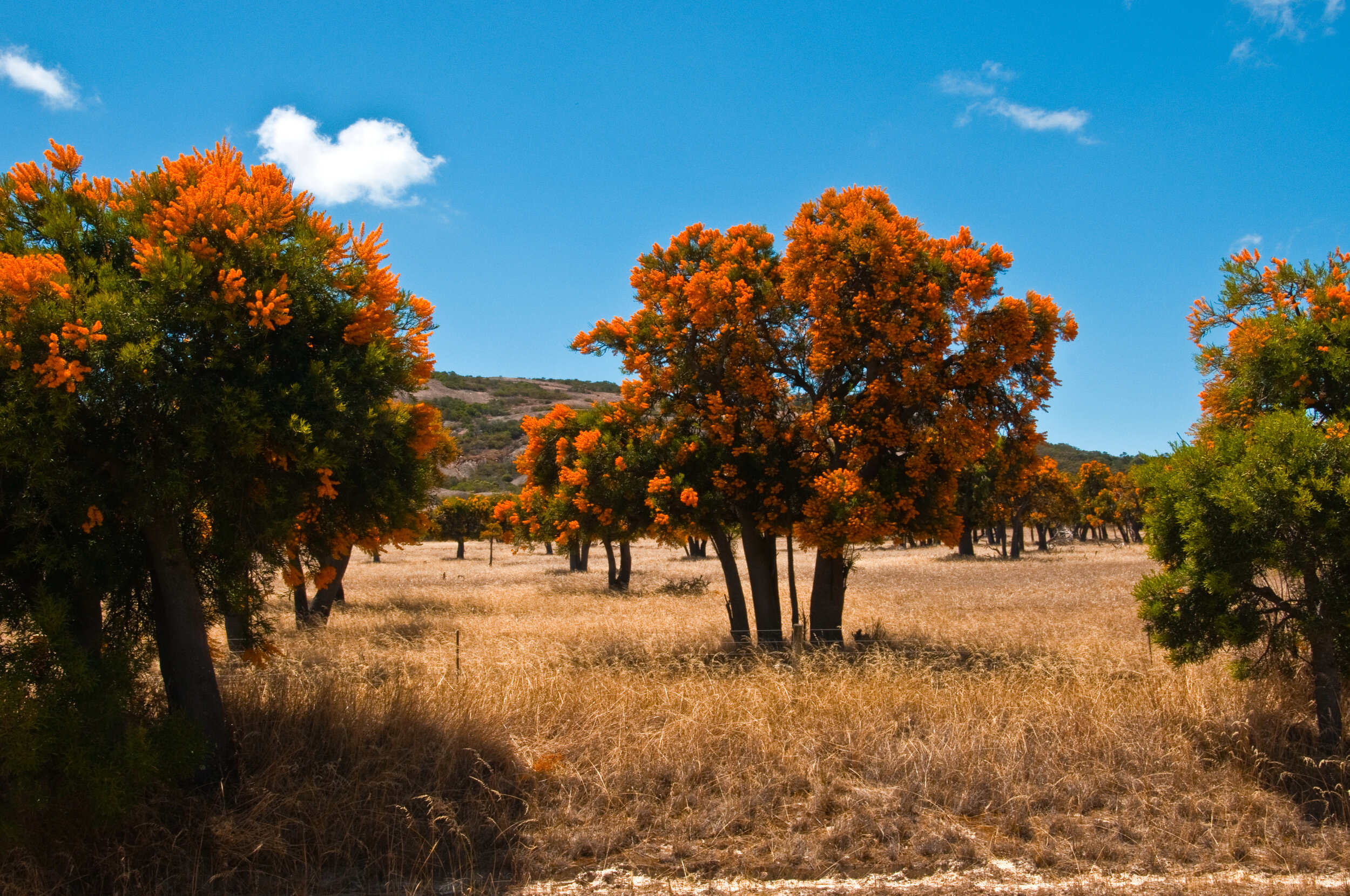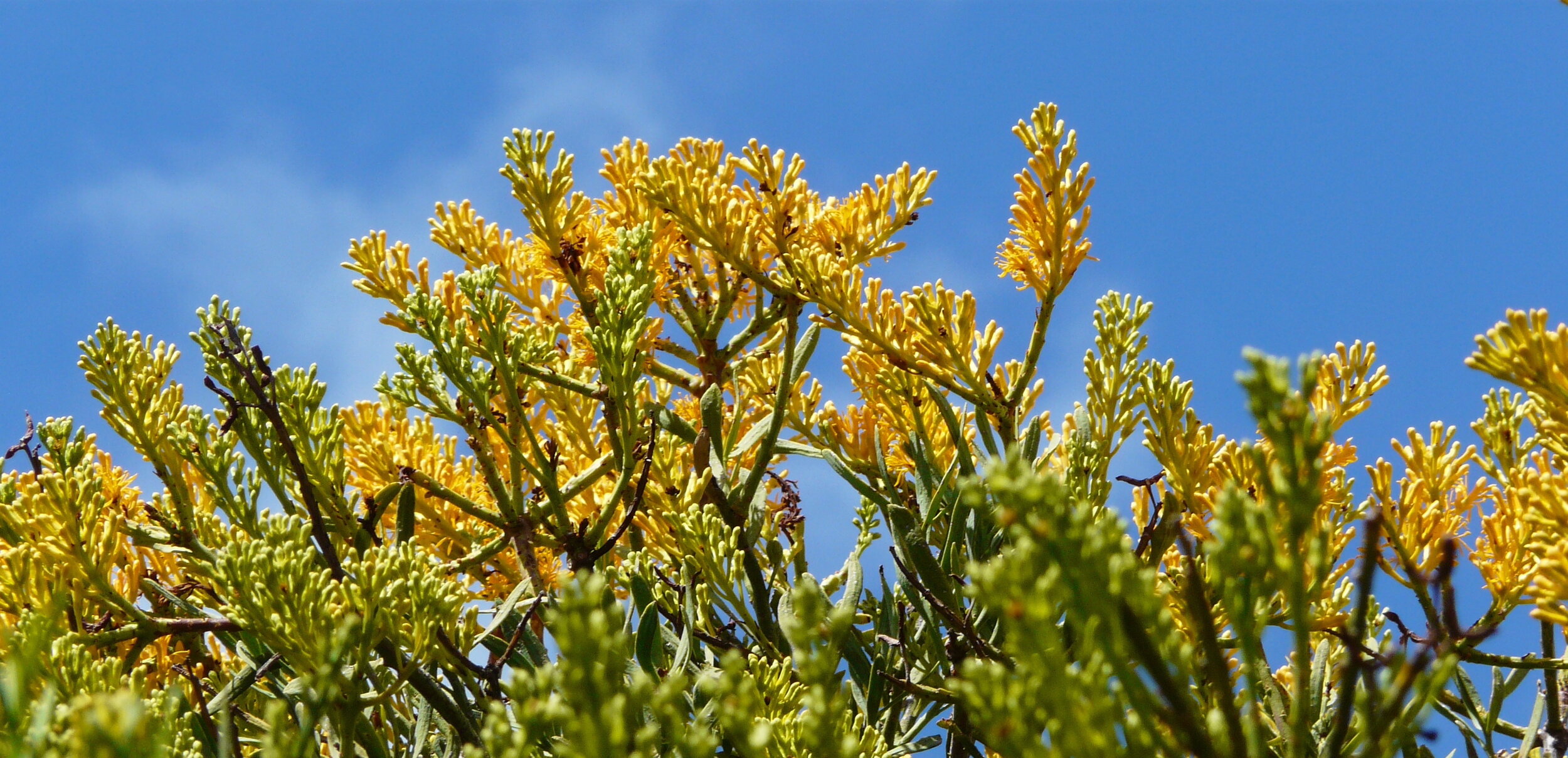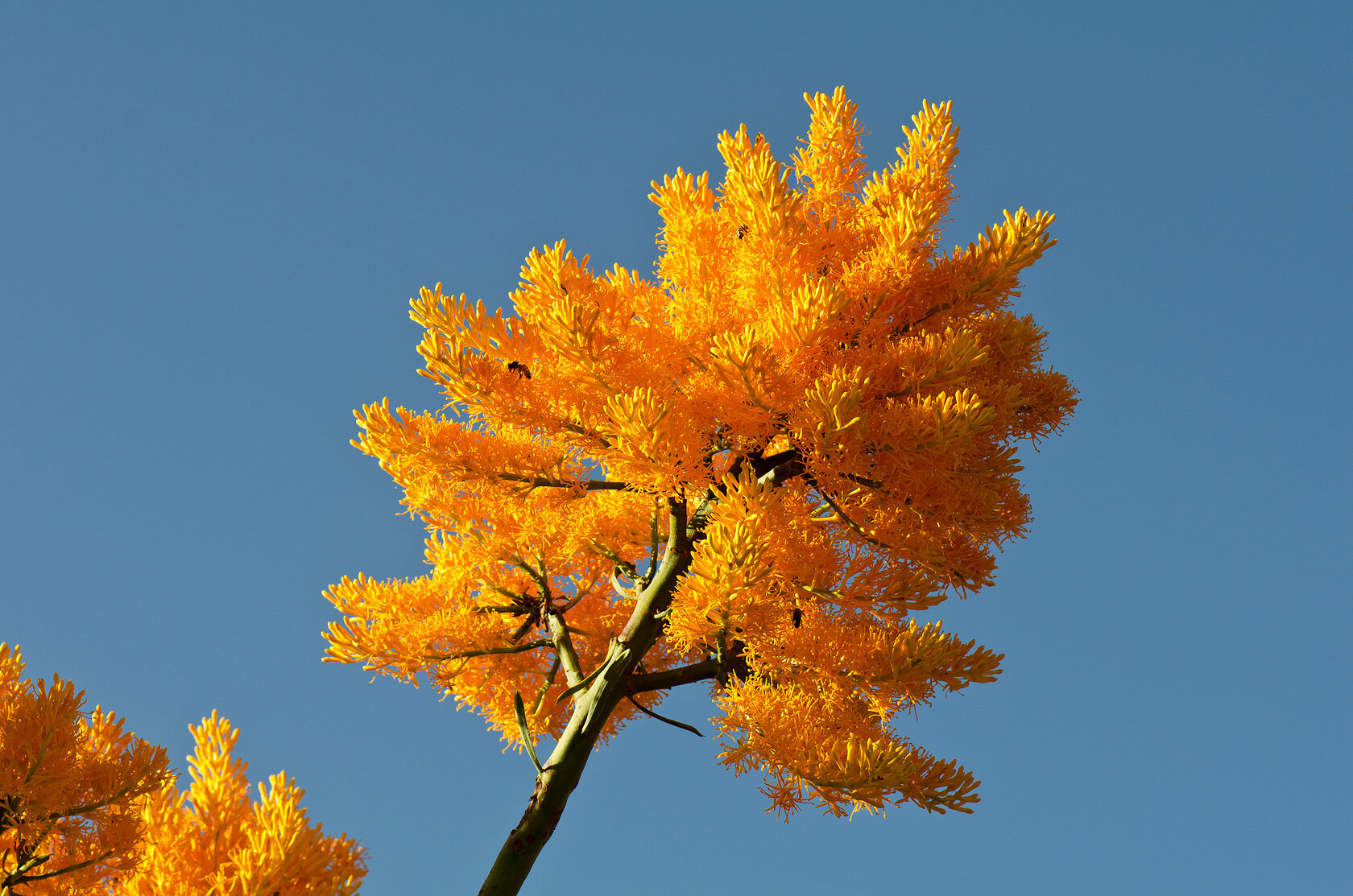Fire Tree
Jessica White
This piece was submitted as part of our Her Words on the World digital series, a partnership with Hedgebrook Women’s Writers Retreat to showcase the work of six talented women writers whose work explores nature and the environment. Visit our exhibit page to learn about the authors.
When her nineteen month old son wandered off after breakfast and drowned in a well obscured by trees, Georgiana Molloy had few resources to deal with her grief. She and her husband, who arrived at Augusta in south-west Western Australia in 1830, were among the first Europeans to establish themselves in the area. She had been born into a wealthy family near Carlisle, England, in 1805, but following her father’s death when she was in her teens, her family life became unstable. When she was courted by Captain John Molloy, her options were narrowing, and although she knew that marriage meant leaving England and travelling 10,000 miles to the other side of the world, she accepted his offer.
Georgiana Molloy, 1805-1843. Public domain. Although copyright has expired, photographic plate attribution reads "Reproduced by permission of Mrs V.M.R Bunbury, 'Marybrook'"
It is difficult, in our present world of Zoom and instant messaging, where a journey that once took 90 days by sea can be flown in a single day, to imagine how isolated the settlers were. Even Georgiana’s family and friends had trouble imagining the distance. She explained, ‘At the Vasse [a settlement to the north of Augusta] we may perhaps have more vessels in, but this year and in general we are not visited here more than three of four times in the year’.[i] To her sister Elizabeth she protested, ‘I fear we are thought inattentive to our friends, but it must always be remembered that we are a hundred and eighty miles from Fremantle, the Port on the Swan, and Vessels only occasionally touch here to supply the wants of a few settlers.’[ii] She described herself and her husband as ‘completely weaned from that sphere of pursuits, actions and modes of life in which we used to move.’[iii] For those who lived in a country where cobbled villages lay but a few miles apart, such remoteness was challenging to comprehend.
Not only this, but Georgiana did not have a close female companion. Three years after her arrival at Augusta, she wrote to her dear friend Helen Storey in England, ‘What golden dreams we used to have about you coming to stay with me! How would you like to be three years in a place without a female of your own rank to speak to or to be with you whatever happened?’[iv] When, in December 1836, she received a box of British seeds from Captain James Mangles, a horticultural connoisseur in London, and a ‘polite note’ requesting ‘a return of the Native Seeds of Augusta,’ a door opened to an astonishing world.
Mangles was friends with the then-governor of Swan River (now Perth) James Stirling and cousin to his wife, Ellen Stirling (and had introduced the couple to each other in England). He was keen to capitalise on the British craze for Australian plants, and asked people in the colony such as James Drummond, who also collected for William Hooker, Director of Kew Gardens, to send him seeds and specimens. Ellen Stirling knew that Georgiana was interested in plants, and suggested that Mangles write to her.
Georgiana had been trained in collecting seeds and creating herbaria as part of her gentlewoman’s education, and in her first letter to Mangles she mentioned that her brother ‘was anxious to employ me as a collector also, my time is so much infringed on I have not as yet sent him any specimens.’[v] As all her ‘former pursuits [had] necessarily been thrown aside (by the peremptory demands of [her] personal attention to [her] children and domestic drudgery)’ she worried that it would take her a while to fill the box with Australian seeds and return it.
Nearly seven months later, her son drowned. Georgiana described the event in detail to Mangles, recounting how her family’s young friend Charlotte pulled John from the well, ‘his little countenance so placid he look’d fast asleep.’ She was not convinced at first that the child was dead, but the doctor was at the Vasse, and ‘that lovely healthy child who had never known pain or sickness and who had been all mirth and joyousness 5 previous hours the last time we beheld him together was now a stiff corpse, but beautiful and lovely, even in death.’ Georgiana apologised to Mangles for ‘thus using towards a Stranger the freedom and minute detail that Friendship warrants and desires,’ and added that ‘[s]ince my dear Boy’s death, I have up to the present time daily employed myself in your service.’[vi]
Wildflowers in south-west Western Australia, copyright Jessica White
It was as though the sorrow that flooded her body transferred itself to her project, because Georgiana quickly became obsessed with collecting. She taught herself about the morphology of the plants she found, learned their names from her correspondence with Manges and from a visiting botanist, Ludwig Preiss, and relayed in long letters the conditions which favoured the seeds’ growth. In 1840, three years after Georgiana began collecting for Mangles, she wrote, ‘scarcely a day passes I am not thinking what I can do or how in any way I could promote your cause, especially when I have so many things of an imperative nature to wholly absorb my thoughts & time — and no female servant.’[vii] She sent several collections of Australian seeds to Mangles and pressed their corresponding flowers, the leaves and petals carefully (and often artfully) arranged, into a hortus siccus – an album of dried plants.
The Nuytsia floribunda took a particular hold on Georgiana’s imagination. When she saw it in the Vasse, an area not far from present-day Busselton to which she and her family later moved, she described it as growing in ‘great abundance, and splendid it is; it looks so rich, among all the sombre Eucalypte [sic] of the present season. It presents to my mind the rich and luxurious trees which adorn Paradise.’ The traditional custodians of south-west Western Australia, the Noongar people, refer to the plant as moodjar (other names include mutdhoor, modyart, mungah, mandelup, modjar, muja, moojar, mooja, mutyal)[viii]. It flowers as the summer gains pace, crowning its host trees with a cloak of golden flowers. From a distance, it looks like the tree is in flame, hence its common name ‘fire tree,’ which was used by colonists until it was replaced by ‘Christmas tree.’ John Lindley, who published the first substantial account of flora in the south-west, A Sketch of the Vegetation of the Swan River Colony (1839–40), comments that ‘such is the abundance of the orange-coloured blossoms, that the Colonists at King George’s Sound compare it to a tree on fire; hence it has gained the name of “Fire tree”’.[ix] Artist and traveller Marianne North described it in 1880, as she travelled from Albany, as ‘a bush-fire without smoke.’[x] One of the paintings in the Marianne North Gallery at Kew Gardens is entitled ‘Study of the Western Australian Flame-tree or Fire-tree.’ Noongar people near Perth saw them as ‘sacred Kaanya trees where the kaa-nya or wee-urn, souls of the spirits of the newly dead were to be found.’[xi] Consequently they did not touch the flowers or leaves, nor shelter beneath it, because, as journalist Daisy Bates (1859-1951) recounts, ‘The souls of all their forebears had rested on the spirit tree.’[xii]
Georgiana was assiduous in trying to collect its seeds and became frustrated at the small number that she gathered. Even as she dwelled in an illness caused by pueperal infection after the birth of her fourth daughter in 1840, she could not stop ruminating on the plant. Her sister, visiting from England, relayed that ‘three times out of four when she came to my Bedside I called out Oh poor Captn Mangles! I cannot go on with his collection, and the seeds of the Nuytsia Floribunda will all be shed.’[xiii] As Georgiana recovered, she continued her search, heading out on horseback with her husband or Noongar guides, but she could not travel far because she was still weak.



The Nuytsia floribunda is a hemiparasitic tree, which will parasitise a wide variety of plant species. While it depends on its host for water and mineral nutrients, it can also produce carbohydrates through photosynthesis.[xiv] The plant sends root-like tendrils known as ‘haustoma’ into the roots of its host by encircling them ‘like a wedding ring on a finger.’[xv] It then cuts into the host’s woody tissue like a secateur and penetrates it with ‘finger-like, cellular intrusions.’[xvi] As well as absorbing nutrients through these dextrous means, it can send out rhizomes for as far as 110 metres. From these rhizomes, branching roots are sent out in search of hosts. One particular specimen, on its search, ended up cutting into telephone wires after mistaking them for roots.[xvii]
The metaphor echoes the relationship between Mangles and Georgiana: he took the bounty of her seeds and hard work and used them to garner prestige in England. He distributed her specimens among horticulturalists and nurserymen in London, including John Lindley, Professor of Botany at University College London, and Joseph Paxton, gardener at Chatsworth and designer of the Crystal Palace at the 1851 Great Exhibition, and the Loddiges nurserymen in London. Despite her lack of formal training, Georgina’s skill and attention to collecting seeds and mounting specimens was recognised and praised. Paxton, on reading copies of her letters to Mangles, commented that ‘they have been written by one who is devoted to the promotion of Botanical interest in this Country and zealously able to fulfil the task of collecting Seeds.’[xviii] Yet, while Mangles was recognised through the naming of Melaleuca manglesii, Grevillea manglesii, Rhodanthe manglesii and Ptilotus manglesii, Georgiana’s work was not recognised through a name until more than a century after her death, in the 1970s. Instead, Mangles sent her books and gifts of silk.
This is not to say that Georgiana did not benefit from collecting. In an undated letter to Mangles of June 1840, she declared that ‘when I sally forth either on foot or Horseback, I feel quite elastic in mind and Step; I feel I am quite at my own work, the real cause that enticed me out to Swan River.’[xix] Writing about the plants to Mangles gave her an opportunity to exercise her literary skill and imagination as she described the plants she encountered. About Xylomelum occidentale, the western woody pear, she wrote: ‘the flowers are of the finest white, and fall in long tresses from the stem, some of its pendulous blossoms, are from three, to five, fingers in length, and these wave in the breeze like Snow wreaths; they are of such a downy white feathery appearance, and emit a most delicious perfume.’[xx] Engaging with the flowers was an aesthetic exercise, one which gave her a chance to leave the house and its associated ‘domestic drudgery,’ and to engage her senses in the bush.
For the whole time that she was in Western Australia, from 1830 until her death in 1843, Georgiana was either pregnant, breastfeeding or had a small child underfoot. As her body carried eight pregnancies (and seven to term), she helped her husband, a resident magistrate, with his business affairs; wrote long letters to Mangles and her family; educated her children; sewed, cooked and washed; and collected seeds and specimens. Throughout all of this, the Nuytsia floribunda blazed brightly, not only among the trees of the south-west, but also in Georgiana’s inner self. Collecting gave her ‘elasticity’ in her mind and body – it took her away from washing, mending and butter making. Being in the bush was, she wrote to Mangles, ‘one of the most delightful states of existence free from every household care, my husband & Children and all I possess on Earth about me.’[xxi]
The plant’s Latin name captures the tension between plunder and benefit in the relationship between Georgiana and Mangles. The name of its genus, Nuytsia, ‘bears the weight of Pieter Nuyts, the violent Dutch explorer and ambassador who mapped Australia’s southern coastline from Albany to Ceduna in 1626 on the Dutch East India Company’s vessel Gulden Zeepaard (Golden Sea-horse).’[xxii] Its species name, floribunda, which translates to ‘flowering freely,’ references the coronet of flowers that covers the tree. This also reflects Georgiana’s inner life, which caught fire through her relationship with Mangles, and which she exerted herself, through writing and collecting, to maintain.
I suspect that part of Georgiana’s desperation to collect the Nuytsia floribunda’s seeds lay in her understanding, however unconscious, that if Mangles no longer needed the plants she collected, her epistolary relationship with him would fade, and she would no longer have a reason to collect specimens. Almost right up until her death (heavily pregnant, once more), she was still trying to collect substantial quantities of the Nuytsia floribunda’s seeds. In her final letter to Mangles, she wrote:
I have been 4 times out in quest of Nuytsia & send you the small, small harvest, they are very difficult to obtain, if not there the very day they ripen, again I have had four sacks of capsula (or seed bearing branches more properly speaking) put gently into a bag, a cloth spread under the tree, and I shall not be able ever to find more than two, rarely, in the capsule, and many which I take to be male flowers. The quantity sent speaks for itself. — I have twice sent natives, once, a man & Native, gone 4 times out myself, twice with a Servant, and twice with Molloy & yet you see the result; I have put some slips into Ward’s glazed box, which brought my Indian plants, ready for embarkation a good opportunity.[xxiii]
This passage – the only part of Georgiana’s letter final copied into Mangles’ letterbooks - shows her drive and fastidiousness, and the knowledge she had gained over five years of collecting, from March 1837 to April 1842. She knew enough to hazard that the flowers were male, and her concern about the preservation of seeds over their long sea journey led her to re-use her Wardian case, a sealed glass box which was a forerunner to the modern terrarium. It enabled living plants to retain their moisture as they were carried across the British Empire.
A year after this final letter to Mangles, in 1843, Georgiana died from another puerperal infection. I do not know if she saw her death coming, but she did understand that every birth was dangerous because it often took a long time for her afterbirth to come away, and professional medical help was often absent (the local doctor travelled long distances and was frequently inebriated). Perhaps another reason for her desperation to capture the blazing, botanical fire before she died was because she saw her own light dimming.
Whenever I look at Nuytsia floribunda, stark and golden against the dry summer grass, I see a woman whose passion ignited her brief life, and I mourn the loss of her intelligence and vitality. At the same time, I recognise her love of Australian flora as a flare, reminding us to care for remarkable plant life we have left.
Footnotes
[i] Georgiana Molloy to James Mangles, 25th Jan 1838, ACC 479A, Battye Library.
[ii] Georgiana Molloy to Elizabeth Besley, 9th November 1832, WAA 501, Battye Library.
[iii] Georgiana Molloy to James Mangles, 25th Jan 1838, ACC 479A, Battye Library.
[iv] Georgiana Molloy to Margaret Dunlop, 12th January 1833, WAA501, Battye Library.
[v] Georgiana Molloy to James Mangles, 21st March 1837, ACC 479A, Battye Library.
[vi] Georgiana Molloy to James Mangles, 25th Jan 1838, ACC 479A, Battye Library.
[vii] Georgiana Molloy to James Mangles, [no date] June 1840, ACC 479A, Battye Library.
[viii] Hopper, Stephen D 2010, ‘660. Nuytsia floribunda’, Curtis's Botanical Magazine (1995), vol. 26, no. 4, pp. 333–368: 337.
[ix] John Ryan, ‘A Very Striking Parasite,’ Griffith Review, ‘Looking West,’ vol. 37. https://www.griffithreview.com/articles/striking-parasite
[x] Cited in Hopper, ‘Nuytsia floribunda,’ 343.
[xi] Hopper, ‘Nuytsia floribunda’, 337.
[xii] Cited in Hopper, ‘Nuytsia floribunda,’ 337.
[xiii] Georgiana Molloy to James Mangles, 22nd June 1840, ACC 479A, Battye Library.
[xiv] Hopper, ‘Nuytsia floribunda,’ 348.
[xv] Hopper, ‘Nuytsia floribunda,’ 355.
[xvi] Cited in Hopper, ‘Nuytsia floribunda,’ 355.
[xvii] Ellie Honeybone and Tom Edwards, ‘WA's native Christmas tree puts traditional pine variety well and truly in the shade,’ https://www.abc.net.au/news/2019-12-24/wa-native-christmas-tree-puts-traditional-pine-variety-in-shade/11810208
[xviii] Joseph Paxton to James Mangles, June 14 1839, ACC 479A, Battye Library.
[xix] Georgiana Molloy to James Mangles, 22nd June 1840, ACC 479A, Battye Library.
[xx] Georgiana Molloy to James Mangles, 14th March 1840, ACC 479A, Battye Library.
[xxi] Georgiana Molloy to James Mangles, 31st Jan 1840, ACC 479A, Battye Library.
[xxii] John Ryan, ‘A Very Striking Parasite.’
[xxiii] Georgiana Molloy to James Mangles, 11th April 1842, ACC 479A, Battye Library.
Jessica White is a writer and researcher living in Australia. She is the author of her hybrid memoir Hearing Maud, Winner of the Michael Crouch Award, as well as the novels A Curious Intimacy and Entitlement. Read our Q&A with Jessica here and visit her website here.
Banner Image: View of Cape Leeuwin Lighthouse, copyright Jessica White.



